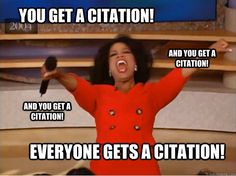
EasyBib, BibMe, Citefast and Writinghouse all offer free online citation generators. Whether students are documenting their sources in APA, MLA, Chicago Style or Harvard Style, they can plug in a reference and these sites can assist in citing within various disciplines. Purdue OWL is also an excellent site to gain knowledge about citations. Giving credit to sources is important in avoiding plagiarism. I talk with students about the responsibilities of research and the temptations of borrowing from multiple sources. The Internet is a virtual playground for ideas, but it is important to acknowledge where the ideas originated. It is tempting to cut and paste, especially since many web pages are formatted and designed in a way that attracts students who may feel overwhelmed synthesizing, summarizing and analyzing sources during their research process.
I include an in-depth unit in my English 1102 online course reviewing common knowledge, when to quote and when not to quote, verbs of attribution, a listing of our College of DuPage Library databases, explanation of different styles and a video summarizing the citation materials. But discussion about citations is not only designated to this specific unit, in fact, we talk about citing sources throughout the course.
Despite emphasizing the importance of citation, some students will still submit “lifted” material for a variety of reasons. For example, this is a book summary assignment from an English 1102 online student this semester. The assignment was to summarize one chapter from a book that directly related to their topic and thesis statement. The student’s original topic was retirement and he was in the process of developing a thesis statement:
An individual can withdraw money from their investment without being penalized. Even if one is still working by the year in which they turn 59 ½, an individual can then take the money out with no penalties. From the years 59 1/2 to 70 1/2, they can take out as much increments of money as they would like. Be it the first year it is $2000 and the next only $100. Once that individual reaches the tax year in which they are 70 1/2 they must take out their entire investment, unless it is in the form of an annuity. Then the minimum amount withdraw is determined by the amount divided by life expectancy.
What happens when an individual starts taking money out of their IRA before the age of 59 1/2? The only way someone can withdraw the money without the tax penalties is if they transfer it to another account, die, or are disabled for a long or indefinite period from engaging in substantial gain able activity. The penalty for taking it out early is you must pay in your income tax that year on how much you took out, and you must pay an additional 10% tax prematurely.
I asked about the source and how it related to the student’s topic and thesis statement. I also asked for references and attribution. Where did this information originate? Was this considered common knowledge? Where is evidence of MLA citation? The student responded via e-mail:
“Apparently I misunderstood the assignment. The rules for the traditional IRA that I summarized haven’t changed sinse 1976 with the age requirements. I thought I just had to summarize sections I read that I can use as information for my paper, but I ended up taking more than I thought from this booklet. I guess it wasn’t a book. Can I do it over?”